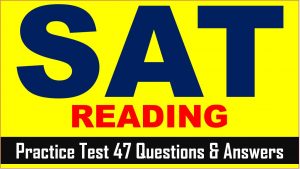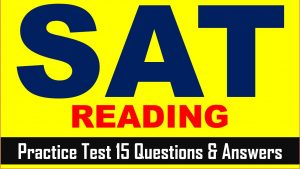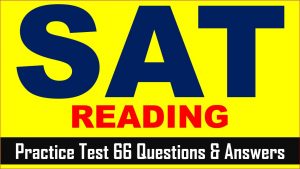SAT (Scholastic Assessment Test) is a standard test, used for taking admission to undergraduate programs of universities or colleges of the United States. SAT is developed and published by the College Board, an organization in the United States, administered by the Educational Testing Service. In this article of AKVTutorials, you will get The Princeton SAT Prep Course Book Review | Practice Test 30 AMBiPi.
The Princeton SAT Prep Course Book Review
The Princeton Review for SAT Premium Book review is given in the article Click Here.
Check Price On Amazon
SAT Reading Practice Passage
This passage is adapted from Kevin Bullis, “What Tech Is Next for the Solar Industry?” ©2013 by MIT Technology Review.
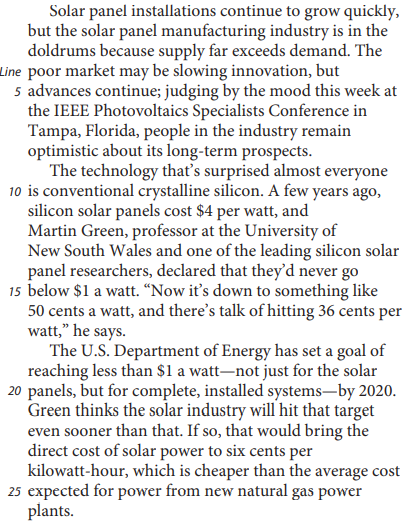
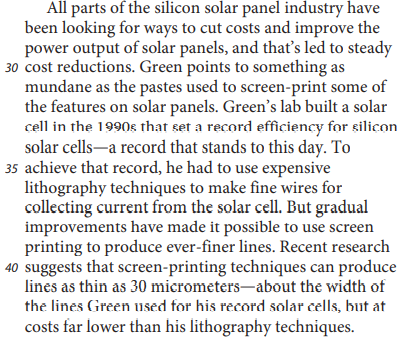
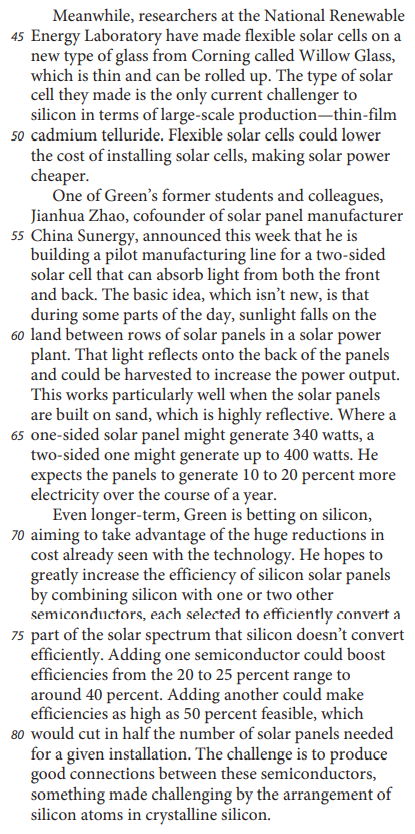
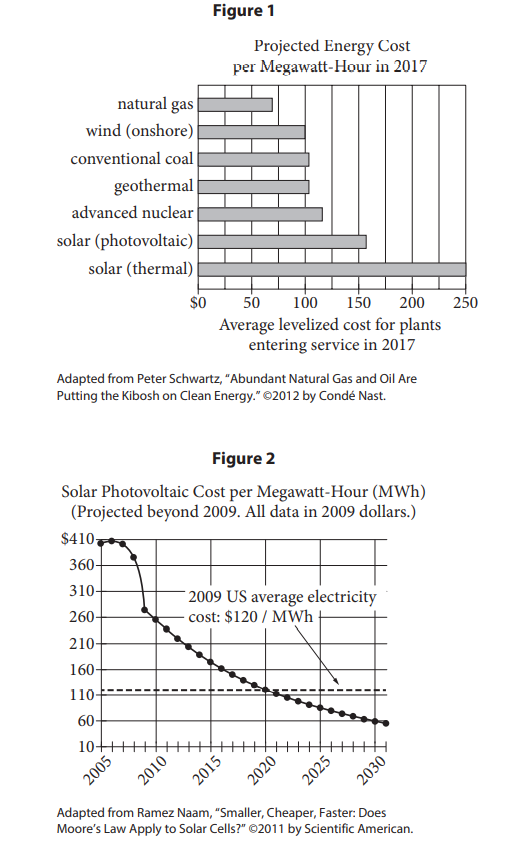
SAT Reading Comprehension Practice Test Questions
SAT Practice Test 30 Question No 1
The passage is written from the point of view of a
Option A: consumer evaluating a variety of options.
Option B: scientist comparing competing research methods.
Option C: journalist enumerating changes in a field.
Option D: hobbyist explaining the capabilities of new technology.
SAT Practice Test 30 Answer No 1
Show/Hide Answer
Option C :
In lines 10-17, the passage illustrates how the cost of solar energy has dropped in recent years: “A few years ago, silicon solar panels cost $4 per watt. . . . ‘Now it’s down to something like 50 cents a watt, and there’s talk of hitting 36 cents per watt.’” In lines 44-47, the passage describes some of the new technology that exists in the field: “Meanwhile, researchers at the National Renewable Energy Laboratory have made flexible solar cells on a new type of glass from Corning called Willow Glass, which is thin and can be rolled up.” Overall, the passage can be regarded as an objective overview of the solar panel industry delivered by a journalist covering the field.
Choices A and D are incorrect because the author does not present himself as either a consumer who plans to buy solar panels or a hobbyist with a personal interest in solar panel technology. Rather, the author focuses on developments in solar technology. Choice B is incorrect because the passage does not discuss research methods used in the solar panel field but rather the technologies that exist in the field.
SAT Practice Test 30 Question No 2
As used in line 4, “poor” most nearly means
Option A: weak.
Option B: humble.
Option C: pitiable.
Option D: obsolete.
SAT Practice Test 30 Answer No 2
Show/Hide Answer
Option A :
In the context of describing the solar panel manufacturing industry as being “in the doldrums because supply far exceeds demand” (lines 2-3), saying it is currently a “poor” market implies it is a weak, or slow, market.
Choices B, C, and D are incorrect because in the context of describing the solar panel manufacturing industry as being “in the doldrums,” saying it is a poor market implies it is a weak market, not a modest one (choice B), a pathetic one (choice C), or an outdated one (choice D).
SAT Practice Test 30 Question No 3
It can most reasonably be inferred from the passage that many people in the solar panel industry believe that
Option A: consumers don’t understand how solar panels work.
Option B: two-sided cells have weaknesses that have not yet been discovered.
Option C: the cost of solar panels is too high and their power output too low.
Option D: Willow Glass is too inefficient to be marketable.
SAT Practice Test 30 Answer No 3
Show/Hide Answer
Option C :
It can reasonably be inferred that much of the solar panel industry believes current solar technology is too expensive and inefficient because the passage states that the industry has been working to improve those two things: “All parts of the silicon solar panel industry have been looking for ways to cut costs and improve the power output of solar panels, and that’s led to steady cost reductions” (lines 27-30).
Choice A is incorrect because the passage explains how solar panels work but never states or implies that consumers do not understand the technology. Choice B is incorrect because while the passage explains how two-sided solar cells can increase solar electric output, it does not suggest that they have any existing or possible weaknesses. Choice D is incorrect because the passage characterizes Willow Glass as entirely promising and doesn’t imply that it is not efficient enough to be marketed.
SAT Practice Test 30 Question No 4
Which choice provides the best evidence for the answer to the previous question?
Option A: Lines 1-3 (“Solar… demand”)
Option B: Lines 10-15 (“A few…a watt”)
Option C: Lines 22-26 (“If so… plants”)
Option D: Lines 27-30 (“All… reductions”)
SAT Practice Test 30 Answer No 4
Show/Hide Answer
Option D :
The passage clearly states how two-sided solar panels will increase the efficiency of solar electricity units, explaining that they will be able to absorb excess reflected light, especially if those panels are built on sand: “That light reflects onto the back of the panels and could be harvested to increase the power output” (lines 61-62).
Choices A, C, and D are incorrect because the passage explains only that two-sided solar panels can raise efficiency by harvesting reflected light, not that they can raise efficiency because they take little energy to operate (choice A), are cost-effective (choice C), or keep sunlight from reaching the ground (choice D).
SAT Practice Test 30 Question No 5
According to the passage, two-sided solar panels will likely raise efficiency by
Option A: requiring little energy to operate.
Option B: absorbing reflected light.
Option C: being reasonably inexpensive to manufacture.
Option D: preventing light from reaching the ground.
SAT Practice Test 30 Answer No 5
Show/Hide Answer
Option B :
The passage clearly states how two-sided solar panels will increase the efficiency of solar electricity units, explaining that they will be able to absorb excess reflected light, especially if those panels are built on sand: “That light reflects onto the back of the panels and could be harvested to increase the power output” (lines 61-62).
Choices A, C, and D are incorrect because the passage explains only that two-sided solar panels can raise efficiency by harvesting reflected light, not that they can raise efficiency because they take little energy to operate (choice A), are cost-effective (choice C), or keep sunlight from reaching the ground (choice D).
SAT Practice Test 30 Question No 6
Which choice provides the best evidence for the answer to the previous question?
Option A: Lines 58-61 (“The basic… plant”)
Option B: Lines 61-62 (“That… output”)
Option C: Lines 63-64 (“This… reflective”)
Option D: Lines 64-66 (“Where…400 watts”)
SAT Practice Test 30 Answer No 6
Show/Hide Answer
Option B :
The previous question asks how two-sided solar panels can raise the efficiency of solar electricity units, with the answer being they can increase solar power input by catching excess reflected light. This is supported in lines 61-62: “That light reflects onto the back of the panels and could be harvested to increase the power output.”
Choices A, C, and D are incorrect because the lines cited do not support the answer to the previous question about how two-sided solar panels can raise the efficiency of solar electricity units, instead highlighting that some sunlight is missed by current units (choice A), explaining why two-sided solar panels work well in sand (choice C), and projecting how much more effective those two-sided solar panels could be (choice D).
SAT Practice Test 30 Question No 7
As used in line 69, “betting on” most nearly means
Option A: dabbling in.
Option B: gambling with.
Option C: switching from.
Option D: optimistic about.
SAT Practice Test 30 Answer No 7
Show/Hide Answer
Option D :
In lines 69-71, the passage states that “even longer-term, Green is betting on silicon, aiming to take advantage of the huge reductions in cost already seen with the technology.” In this context, the phrase “betting on” most nearly means “optimistic about,” as the sentence implies that Green has positive expectations for silicon use now and in the future.
Choice A is incorrect because “dabbling in” a subject implies being only minimally involved with it, but in lines 69-71, Green is shown to be committed to silicon use. Choice B is incorrect because in this context the phrase “betting on” is figurative and implies believing in something, not actually being involved with games of chance. Choice C is incorrect because Green is said to want to “take advantage” of silicon use, meaning he does not intend to switch from it.
SAT Practice Test 30 Question No 8
The last sentence of the passage mainly serves to
Option A: express concern about the limitations of a material.
Option B: identify a hurdle that must be overcome.
Option C: make a prediction about the effective use of certain devices.
Option D: introduce a potential new area of study.
SAT Practice Test 30 Answer No 8
Show/Hide Answer
Option B :
The passage concludes by stating that “the challenge is to produce good connections between these semiconductors, something made challenging by the arrangement of silicon atoms in crystalline silicon” (lines 81-84). As this last sentence identifies an issue the solar panel industry still faces, and describes it as a “challenging” one at that, it mainly serves to identify a problem or hurdle that must be dealt with by the industry.
Choices A, C, and D are incorrect because the main point of the passage’s last sentence is that there is a “challenge” or hurdle that the solar panel industry has to deal with; it doesn’t express concerns about what a material won’t be able to do (choice A), make predictions (choice C), or introduce a new idea for study (choice D).
SAT Practice Test 30 Question No 9
According to figure 1, in 2017, the cost ofwhich of the following fuels is projected to be closest to the 2009 US average electricity cost shown in figure 2?
Option A: Natural gas
Option B: Wind (Onshore)
Option C: Conventional coal
Option D: Advanced nuclear
SAT Practice Test 30 Answer No 9
Show/Hide Answer
Option D :
Figure 2 shows that in 2009, the US average electricity cost per megawatt-hour (MWh) was $120. Of the projected 2017 energy costs for fuels listed in figure 1, the one closest to the 2009 US average electricity cost 120 dollars per megawatt-hour is the projected cost of advanced nuclear energy, estimated at just below 125 dollars per megawatt-hour.
Choices A, B, and C are incorrect because figure 1 shows the projected energy costs of natural gas, wind (onshore), and conventional coal as just below 75 dollars per megawatt-hour, 100 dollars per megawatt-hour, and approximately 105 dollars per megawatt-hour, respectively. None of these costs is as close to the 2009 US average electricity cost of 120 dollars per megawatt-hour as the projected 2017 cost of advanced nuclear energy, which is just below 125 dollars per megawatt-hour.
SAT Practice Test 30 Question No 10
According to figure 2, in what year is the average cost of solar photovoltaic power projected to be equal to the 2009 US average electricity cost?
Option A: 2018
Option B: 2020
Option C: 2025
Option D: 2027
SAT Practice Test 30 Answer No 10
Show/Hide Answer
Option B :
Figure 2 shows that the dropping cost of solar photovoltaic power per megawatt-hour is projected to intersect with the 2009 US average electricity cost of 120 dollars per megawatt-hour in the year 2020.
Choice A is incorrect because figure 2 projects that the solar photovoltaic cost per megawatt-hour in 2018 will be approximately $140, which is more than the 2009 US average electricity cost of 120 dollars per megawatt-hour. Choices C and D are incorrect because figure 2 projects that the solar photovoltaic cost per megawatt-hour will be around $90 in 2025 and $70 in 2027, both of which are less than the 2009 US average electricity cost of 120 dollars per megawatt-hour.
The Princeton Review for SAT Premium Book review is given in the article Click Here.
Check Price On Amazon


